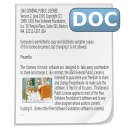Clasificación de texto con NLP en tweets relacionados con desastres naturales
Resumen
Actualmente existe una gran cantidad de información circula a través de las redes sociales, esta no siempre tiende a ser verídica y tratándose de desastres naturales su falsedad podría llegar a tener bastante consecuencias como histeria colectiva en la población. Para evitar esto se propuso un análisis eficiente para la comprobación de tweets con información falsa utilizando algoritmos de procesamiento de lenguaje natural.
Descargas
Citas
S. K. Theja Bhavaraju, C. Beyney y C. Nicholson, "Quantitative analysis of social media sensitivity to natural disasters", International Journal of Disaster Risk Reduction, vol. 39, p. 101251, octubre de 2019. [En línea]. Disponible: https://doi.org/10.1016/j.ijdrr.2019.101251 DOI: https://doi.org/10.1016/j.ijdrr.2019.101251
S. Hansson et al., "Communication-related vulnerability to disasters: A heuristic framework", International Journal of Disaster Risk Reduction, vol. 51, p. 101931, diciembre de 2020. [En línea]. Disponible: https://doi.org/10.1016/j.ijdrr.2020.101931 DOI: https://doi.org/10.1016/j.ijdrr.2020.101931
F. K. Sufi, "AI-SocialDisaster: An AI-based software for identifying and analyzing natural disasters from social media", Software Impacts, p. 100319, mayo de 2022. [En línea]. Disponible: https://doi.org/10.1016/j.simpa.2022.100319 DOI: https://doi.org/10.1016/j.simpa.2022.100319
S. Deb y A. K. Chanda, "Comparative analysis of contextual and context-free embeddings in disaster prediction from Twitter data", Machine Learning With Applications, vol. 7, p. 100253, marzo de 2022. [En línea]. Disponible: https://doi.org/10.1016/j.mlwa.2022.100253 DOI: https://doi.org/10.1016/j.mlwa.2022.100253
Y. Lian, Y. Liu y X. Dong, "Strategies for controlling false online information during natural disasters: The case of Typhoon Mangkhut in China", Technology in Society, vol. 62, p. 101265, agosto de 2020. [En línea]. Disponible: https://doi.org/10.1016/j.techsoc.2020.101265 DOI: https://doi.org/10.1016/j.techsoc.2020.101265
Raina, V., Krishnamurthy, S., “Natural Language Processing”. In: Building an Effective Data Science Practice.Apress, Berkeley, CA, diciembre de 2021 Disponible. https://doi.org/10.1007/978-1-4842-7419-4_6 DOI: https://doi.org/10.1007/978-1-4842-7419-4_6
K. R. Chowdhary, Fundamentals of Artificial Intelligence. New Delhi: Springer India, 2020.[En línea]. Disponible: https://doi.org/10.1007/978-81-322-3972-7 DOI: https://doi.org/10.1007/978-81-322-3972-7
J. K. Tripathy et al., "Comprehensive analysis of embeddings and pre-training in NLP", Computer Science Review, vol. 42, p. 100433, noviembre de 2021. [En línea]. Disponible: https://doi.org/10.1016/j.cosrev.2021.100433 DOI: https://doi.org/10.1016/j.cosrev.2021.100433
Kelleher, J. D. (2019). Deep Learning. MIT Press. DOI: https://doi.org/10.7551/mitpress/11171.001.0001
Yadav, A. y Vishwakarma, D. K. (2019). Sentiment analysis using deep learning architectures: a review. Artificial Intelligence Review, 53(6), 4335–4385. https://doi.org/10.1007/s10462-019-09794-5 DOI: https://doi.org/10.1007/s10462-019-09794-5
Derechos de autor 2023 Innovación y Software

Esta obra está bajo licencia internacional Creative Commons Reconocimiento 4.0.
Los autores ceden en exclusiva el derecho de publicación de su artículo a la Revista Innovación y Software, que podrá editar o modificar formalmente el texto aprobado para cumplir con las normas editoriales propias y con los estándares gramaticales universales, antes de su publicación; asimismo, nuestra revista podrá traducir los manuscritos aprobados a cuantos idiomas considere necesario y difundirlos en varios países, dándole siempre el reconocimiento público al autor o autores de la investigación.
























